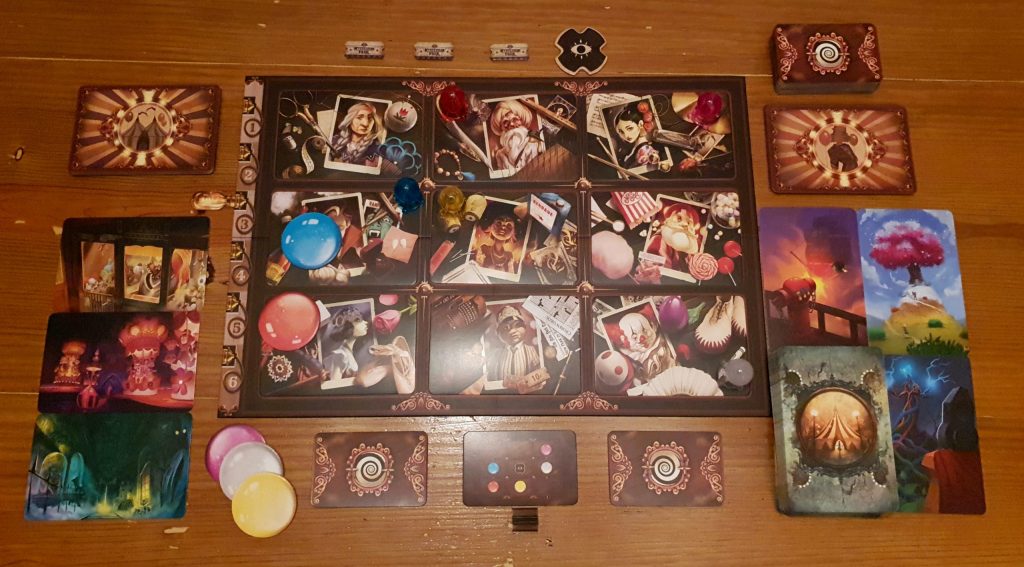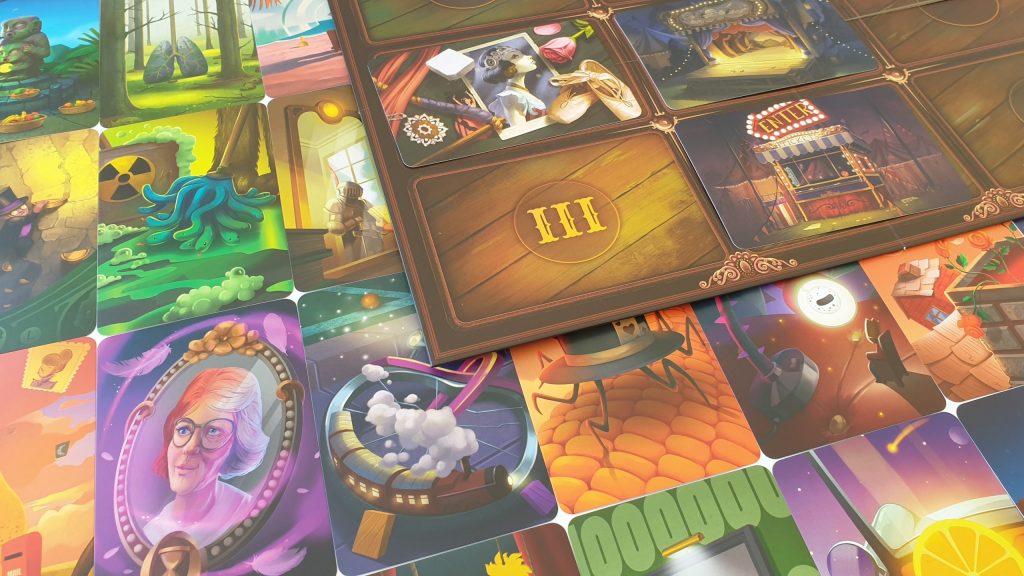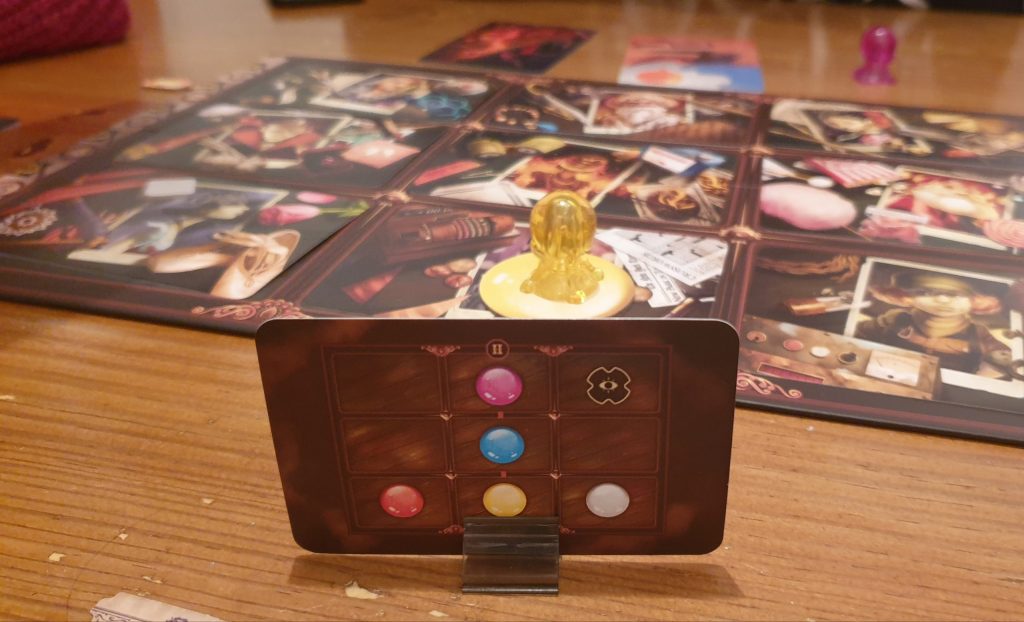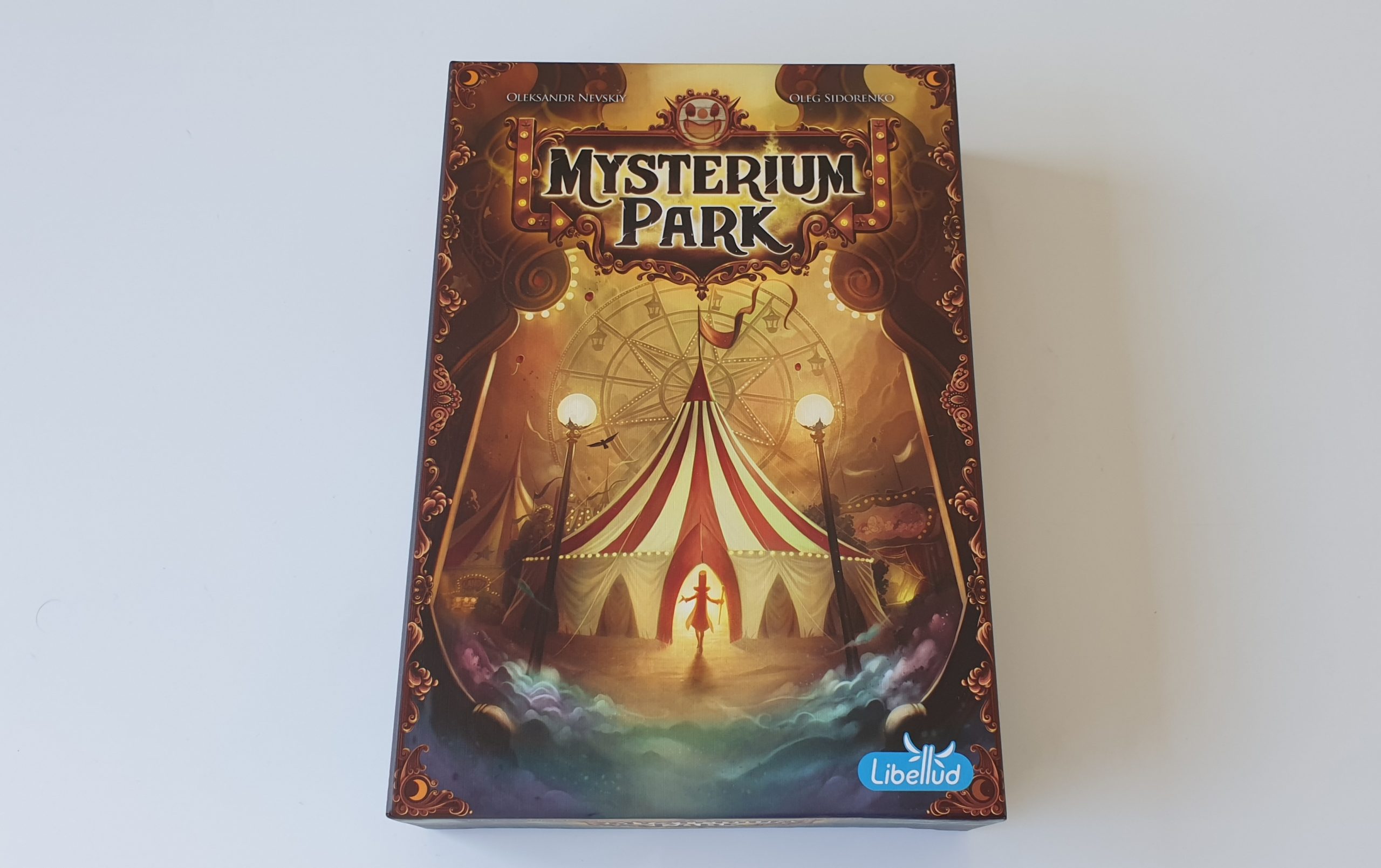Mysterium Park is the brand new murder mystery like cooperative board game from publisher Libellud. Coming from the designers of the original Mysterium, Oleksandr Nevskiy and Oleg Sidorenko, this sees 2 – 6 players using cards featuring abstract artwork to deduce a culprit and the crime scene. Mysterium Park offers a shorter experience than the original, with games lasting around half an hour. However, does the game suffer or thrive from the shorter time and new setting? Let’s find out!
At the offset of the game one player will take up the role as the ghost, with the rest of the players becoming the psychics. Importantly, all players are working cooperatively – despite the different roles. The ghost will be guiding the psychics through their investigation via vision cards, hinting to players about characters and locations that are in front of them. This is the only communication that the ghost player can give.
The game is split into 3 rounds, though players may not always advance forward – having to repeat a round. In the first two rounds players will be tasked with choosing a person and a location respectively, from a grid of nine cards. This grid is set up by the ghost player. In round one for example there will be nine character cards placed on the central 3 x 3 grid. A plot card will indicate to the ghost which character is to be chosen by which player. These plot cards feature the same 3 x 3 grid, with 5 coloured orbs representing the psychic colours, three empty spaces and a witness space.

The ghost will hand out to each player one or more vision cards, from their hand of 7. The aim for the ghost here is to pick cards that link in some way to the character a player must choose. The overall colour of a card might be a clue, a certain object or item might also be seen on both or perhaps the ghost just thinks the vibe of the vision matches. The players are free to discuss but they must all individually choose which of the nine characters they think their vision relates to. As each player is being linked to a different character no two players should pick the same card, though someone else could always be wrong.
Once all players have chosen, by placing their coloured intuition pawn on a character, it is time to see who was right. If any player chose the witness space it is triggered first, with the witness revealed and the player(s) involved able to have another guess. The witness character card is removed and replaced with the witness token – in case round one is to be repeated. Those that guessed correctly discard their character card, marking the space with their coloured innocent token – they were not the murderer. These players can then freely discard their vision cards. If a psychic has made an incorrect guess their intuition pawn is removed, vision cards are kept and the round will be repeated with another vision card given to the players still in.
This continues until all players have successfully chosen the right character card. Round two is performed the same but instead of eliminating a character it is about determining a location. At the end of both round one and two the ghost collects the 3 cards that match the blank spaces on their plot card, with a new plot card used for each round. If players manage, as a group, to guess all of the characters and locations before the end of the sixth round then everyone enters round three – where the true culprit is revealed. This sees the 3 character cards and 3 location cards left over from the rounds combined into 3 character location pairs. These are laid out on the central grid under the marks I, II and III. A final plot card is used by the ghost to indicate which is the correct culprit and crime location. Using only two vision cards, one for the character and one for the location, the ghost must hint to all of the psychics which pair to pick. Winning or losing as a group the psychics hopefully deduce the right pair and the ghost’s soul can now rest in peace.

With Mysterium Park being in party game territory, there was one major thing holding back the original. It simply took too long to set up. While that never stopped most enjoying the experience, Mysterium Park is much quicker to get to the table. Dealing cards out to the central board is quicker than lining up the rows of cards in Mysterium. In addition, there is a lot less admin in sorting out which cards relate to which player – thanks to the plot cards. An additional benefit of having no screen to set up is the ghost player isn’t forced to constantly peer over to look and check – with the plot card and the full board easily in sight at one time. Less admin on the ghost’s part also makes it easier for first time ghosts, though it is still advisable for the most experienced player to be the ghost for the first few games.
With 60 plot cards included there is no worry regarding replayability. Pulling a random plot card from the deck, no one will have any idea which character or location applies to them. The choices are whittled down in the same way as the original, as when others have correctly guessed those cards are removed. There are always nine cards included, which does up the difficulty a bit for lower player counts. The witness is always there though to help out.
By far the best change to keep everyone engaged is the tweak to the final round. In Mysterium players would see a number of cards based upon points scored. This could see players seeing different amounts of cards – slightly splitting the group up. In Mysterium Park everyone is equally involved, which makes more sense as the group either wins or loses together. Not having the points earnt is also one less thing to track during play.

Although with the expansions the original has more variety in the cards, the same logic can extend the use of those cards to Mysterium Park. The large tarot card like size is identical across both games and the expansions. Realistically with 84 vision cards you’ll never really need more. Still, if you wanted to you could combine the decks. This isn’t only for the vision cards. While the character and location cards included in this game are heavily linked to the carnival/park theming, they also match up size wise and in art style. So, you could draw from the original game for those too. It is key to point out though that without owning the original there are plenty of cards included, with the potential for numerous games played before they start being reused, if working through the decks and not shuffling.
One thing you cannot say about Mysterium Park is that the box is empty: it crams a lot into the slimline box! The only thing missing from Mysterium Park is the sand timer that gave some urgency to the psychic players, when choosing what their received vision cards were hinting towards. As a result the rounds do last a little longer. It opens up the ability for players to talk through and discuss their decisions, so people can be swayed away from correct or incorrect choices by others. There is the chance for analysis paralysis to creep in though, which the sand timer used to stop.
Everything is wrapped into the slightly creep carnival park theme, from the professions of the characters to the locations – so there is a consistent vibe. Losing the need to determine a weapon from the original, Mysterium Park slightly loses the Cluedo (Clue) like structure of person, place and weapon. While having that trio feels natural the game isn’t worse for leaving out the weapon section. Not having this additional round is where a good chunk of the saved time comes from. For the slicker setup, the reduced playtime but not reduced entertainment, it is hard to see going back to Mysterium – after playing Mysterium Park. As the majority of the cards can be used in Mysterium Park, it is unlikely that the original will lose it’s space on the shelf but it is certainly on the edge. For those new to the series though, Mysterium Park is the version to go for.
(Editor’s Note: Mysterium Park was provided to us by Asmodee for the review. The game is currently available from local board game stores! Find your local store here.)

